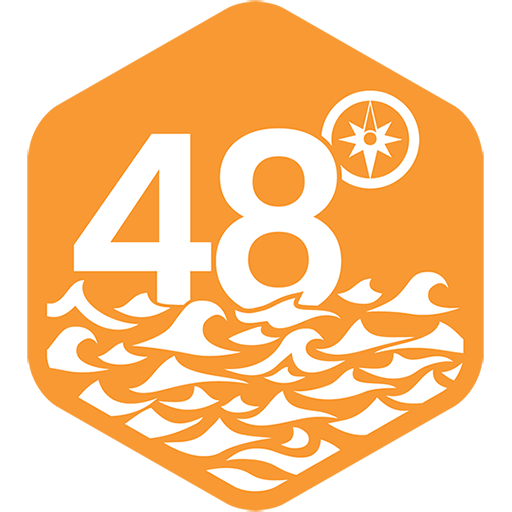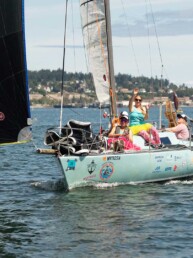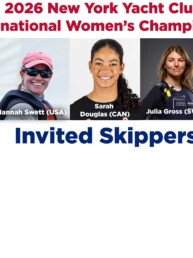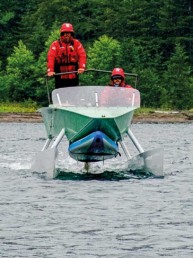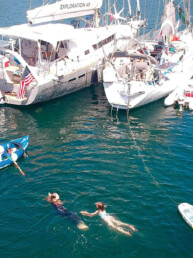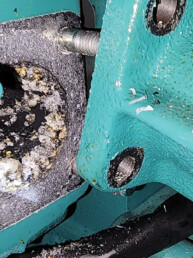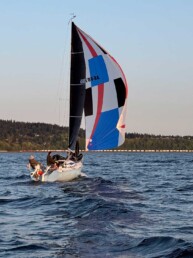A monohull sailor’s experience diving into the world of multihulls.
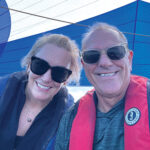 Do you really want to be heeled for 20 days?” asked Pete McGonagle, one of the foremost experts on ocean-going catamarans, as we consulted about my next boat purchase and the implications for long passages. I thought about it for a moment and considered factors like speed capabilities (where multihulls regularly outperform similar length monohulls), stowage capacity, livability, a stove that doesn’t need to gimbal, and the prospects of being the social magnet at anchor with ample space to entertain. I started to warm to the idea. Also, since I run an expedition sailing school, I could see that a catamaran would also be a great teaching platform for new cruisers considering multihulls. “But I really like heeling and worry about a multihull’s poor upwind performance… and what about capsize implications?” said a tiny voice in my head. And the ultimate question was, “Will I enjoy sailing a cat as much as a monohull?”
Do you really want to be heeled for 20 days?” asked Pete McGonagle, one of the foremost experts on ocean-going catamarans, as we consulted about my next boat purchase and the implications for long passages. I thought about it for a moment and considered factors like speed capabilities (where multihulls regularly outperform similar length monohulls), stowage capacity, livability, a stove that doesn’t need to gimbal, and the prospects of being the social magnet at anchor with ample space to entertain. I started to warm to the idea. Also, since I run an expedition sailing school, I could see that a catamaran would also be a great teaching platform for new cruisers considering multihulls. “But I really like heeling and worry about a multihull’s poor upwind performance… and what about capsize implications?” said a tiny voice in my head. And the ultimate question was, “Will I enjoy sailing a cat as much as a monohull?”
In the end, it was my combined passions for sailing and scuba diving that pushed me over the multihull edge. It is of course possible to scuba dive from a monohull, but it is more logistically complex, given my past experience on monohulls. With the decision made, the search began. The obvious choices—Gunboat, Outremer, Antare—were out of my somewhat meager price range, but the typical production catamaran would likely fall short of my high expectations for ocean-crossing capability and as a teaching platform. It was clear that I needed to prioritize my wish list.
Fortunately, I have taught ASA sailing courses on over a dozen monohulls and six catamarans, which gave me a pretty good idea of what I didn’t want. So what did I want? Limited available inventory in the Pacific Northwest made what I wanted less relevant, as there just weren’t many options. Any internet search for ocean-capable catamarans on the west coast typically yielded just a handful of choices. In fact, it was almost a year before the first viable boat showed up.
Nine months into the cat-buying journey, I made my first offer—a 2001 Leopard 48 located in Sidney, B.C. There was no question about the suitability of this design to cross oceans, and after my pre-survey offer was accepted, we scheduled the haul-out. My first lesson in costs associated with handling a multihull quickly followed. It turns out there are only a handful of options to pull a catamaran with a 24-foot beam out of the water in southern British Columbia. While it can be done with a sling or even in some cases a crane, a common option is to lower forms into the water on a boat ramp, adjusted for the boat, and use a tractor to pull the boat out. My surprise came when, at a reputable yard in Canada, the cost was $3,600 for the haul-lout alone. Post survey, it was clear this boat required more work than I was willing to invest in, so I moved on, eating a bit more in cost than I forecast or hoped.
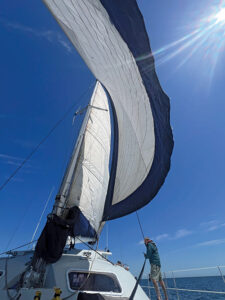
improve upwind performance.
Six months later, the second viable option surfaced through complete luck, and I was able to contact the owner about a week before the listing went live. This was a very unique French catamaran—a Soubise Plaisance 50 with a rotating carbon fiber mast, skinny hulls, and composite shrouds. The patience was worth it, here was a performance catamaran that had crossed the Atlantic, transited the Panama Canal, sailed to Hawaii and was now in my home waters of the Pacific Northwest. With my pre-survey offer accepted, I scheduled a haul-out in Bellingham, one of two yards in Puget Sound that can haul-out a boat with a 25.5-foot beam. I was delighted to learn that the haul-out was a mere $975, much more reasonable compared to my experience in Sidney. The challenge was that the sling-based lift had a maximum width of 26-feet, so with just inches to spare there wasn’t room for fenders. Though mildly terrifying to watch, the process ended with survey results that seemed workable. Two months later (and after some negotiation), I was the proud owner of Koru.
The next set of lessons presented themselves quickly as my partner Renée and I worked to refit and repair in preparation for a three-month cruise to northern British Columbia and Haida Gwaii. In addition to the initial sticker-shock from needing “two of everything” I quickly realized the financial implications of comparatively long runs for things like water, electrical, and sanitation lines.
There was one challenging problem related to catamarans specifically: the very sensitive hydronic diesel heater. ABYC standards allow no more than a 10% drop in voltage and, with a catamaran of this size, if long electrical lines cross hulls and come back, lengths of a single run can exceed 100-feet. Long runs like this can cause voltages to drop significantly. We found that Koru’s heater worked great when the batteries were fully charged, but would error “low voltage” when the battery capacity dropped by about 50%. Many frustrated hours later, we figured out the issue and ran a thicker gauge electrical wire.
The next surprise impact of long runs came when trying to understand the inconsistent performance of Koru’s VacuFlush heads. In her 50-foot hulls with holding tanks in each bow locker, I found that these runs exceed some product specifications. As is so often the case, timing is everything and sadly we did not discover this interesting limitation until we were well underway in British Columbia. Fortunately, we had a wonderful group of friends with us who all pitched in on the troubleshooting activities. One of our guests was even kind enough to write a song about our shared sanitation adventure, complete with ukulele accompaniment, that stills inspires belly laughs among the crew.
No consideration of catamarans is complete without discussing the risks of capsizing. I get asked about this quite often and did a fair amount of my own research. Without citing specific numbers (as no publicly available source provides comprehensive data), the documented cases mostly come from very high performance catamarans in racing situations. Available data suggests that the risks of loss are not higher with either a monohull or a catamaran, the risks are just different. On a monohull, the keel ensures you will sink if you are taking on water but if you’re rolled and the keel stays attached, the boat will right itself and not sink. On a catamaran, if you capsize, it will not sink but it’s highly unlikely the vessel will ever be righted again. However, even if one hull is holed in a collision, the boat will stay afloat. Neither (as far as my research supports) is more or less likely of a scenario than the other. In both cases, solid seamanship and being aware of the risks is the safest, most prudent approach.
Now, let’s finally talk about sailing! The first thing I noticed when the sails were up was how different it felt to be moving fast with essentially no heel, both in light winds and in stronger breeze. With 15 knots of wind, we could see very modest heeling, maybe 6-8 degrees, on a beam reach. Not having to “prepare to put out sails” by checking all the level surfaces for potential projectiles was both pleasant and different. The next surprising experience came from just how much the traveler was used for mainsail trim (typical of most catamarans). Koru has a 20-foot traveler and this, it turns out, is a joy to sail with. Powering and depowering the huge mainsail was a breeze as was safely jibing because the mainsheet is typically more tightly sheeted than on a boat with a narrower traveler. During sea trials, we were able to get 6.5 knots of boat speed in 4.5 knots true wind on both a beam reach and a close reach. This has been reinforced many times over since then—the boat is reliably faster than wind up to about 8 knots or so. As we’ve continued getting to know Koru, I’ve found that in 12-16 knots of true wind, we make boat speeds consistently in excess of 10 knots with 14 knots often within reach on points of sail ranging from a broad reach all the way to a close reach, sometimes even into close hauled. This sailing performance, combined with under-power speeds of 9 to 12 knots have opened doors to regular 100-plus nautical mile cruising days that still end at anchor well before dark. The previous owner said that she has 300-mile days in her past.
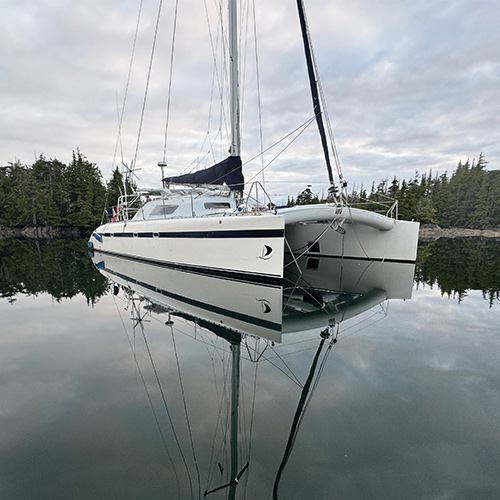
Other questions that often come up are: Is tacking really that different on a catamaran? And, how high can multihulls point going to weather? On the first question, this is a significant issue on most catamarans. We have gotten stuck in irons a handful of times with the mainsail acting like a giant windvane as Koru tracks disconcertingly backwards. Once we understood precisely how far to overshoot the tack, we have not experienced that problem much since. In lighter winds, backwinding the jib helps significantly. Compared to other production catamarans I’ve taught on, Koru is much better behaved, but I still need to be aware of these nuances when tacking.
On the question of upwind performance, one often overlooked constraint is the placement of the jib cars—if you can’t make an efficient slot between the jib and the main, you just can’t reliably point close to the wind. As an experiment, see how high your monohull will point with the jib completely furled, I think you’ll be surprised. I was! Clearly there are other factors but fundamentally if you can’t shape the jib and make the sails work well together, the boat just won’t point. This is where production catamarans often see their limitations, especially with self-tacking jibs forward of the mast or cars placed too far outboard. For Koru, this is a strength with jib cars positioned closely athwartships and aft of the mast, allowing a narrow slot and a great ability to help the two sails work as one. With the both sails well trimmed and tightly sheeted, she can point close to 35 degrees to the apparent wind. Add her exceptional speed and the associated apparent wind increases in lighter breeze, and VMG upwind is impressive.
Koru has very skinny hulls with extremely low wetted surface area. This increases her mathematical hull speed to around 11 knots (with the capacity for planing when going faster). What we give up for this performance upside is the walk-around queen sized bed in every cabin found in many seemingly similar catamaran options. There are always choices and tradeoffs in boat design, it’s just a matter of your priorities. And like boats of all types, upwind performance is also significantly influenced by underwater appendages. The shape of Koru’s keels is quite aggressive for limiting lateral resistance and have close to (though not quite) the effectiveness of daggerboards found on high performance catamarans.
While upwind performance is an intriguing question on catamarans—mainly because some don’t excel at it—upwind performance also varies widely among monohull designs. That’s certainly been my experience for the three different monohulls I’ve owned and the other monohull designs I’ve used as a sailing instructor. Upwind performance will increase your VMG when you find yourself sailing to weather, and PNW sailors may sail upwind more than counterparts in many other cruising hot spots around the globe. But upwind prowess is seldom priority number one for cruisers who are usually hoping to make most of their miles off the wind and, interestingly, upwind performance doesn’t always correlate with downwind performance. Even by removing the heel from the equation, heading into a seaway is not most cruisers’ idea of a good time. So it doesn’t take long to realize this is not just a monohull-versus-catamaran discussion!
I’ll close by returning to my central question, “Will I enjoy sailing Koru as much as my monohull?” The answer is a surprising and resounding “Yes!” I admit this was my biggest concern with a catamaran. Teaching students how to sail a catamaran and watching the relative disappointment of traveling at “only 8 knots” is truly priceless. Add in all the optimizations and tweaks with the rotating mast, the option for a screecher (which is a bit more accessible to newer sailors than a spinnaker), and the space and stability of the platform—and she becomes a true joy on any point of sail.
Finally, I have been both surprised and delighted by the social aspects of Koru. People walk up and ask about her, striking up new conversations everywhere I go. With two large sugar scoop transoms, I even had two paddleboarders visit us at anchor and stay for drinks. Sailing a monohull still tugs at my heart from time to time; but with all of this catamaran’s capabilities, benefits, and outright fun, I don’t spend much wishing for anything else.
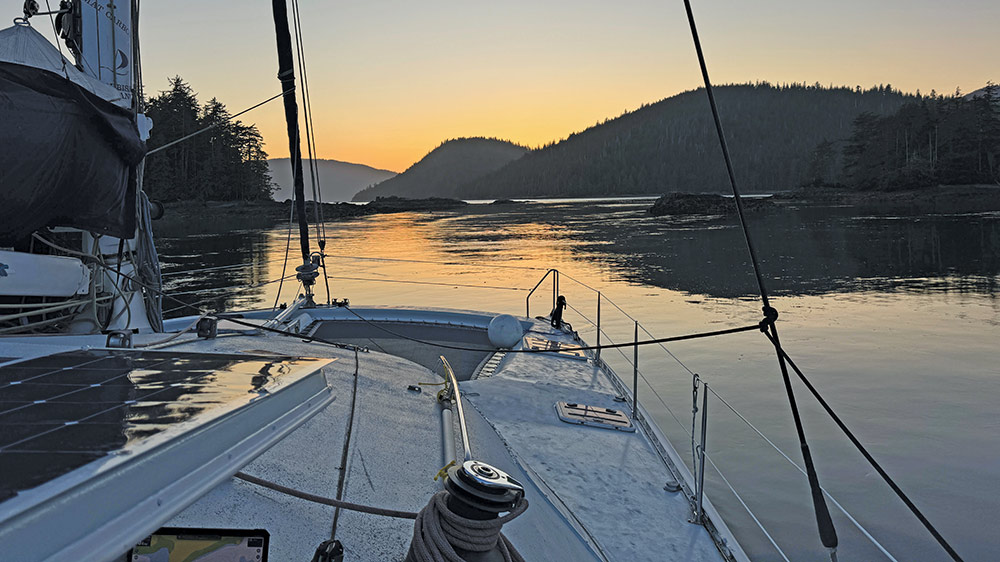
Ken Parker, co-owner of Koru Expeditions, is an ASA instructor, ASA Affiliate School director, and PADI dive instructor. This summer Koru can be found touring British Columbia and up to Alaska with the summer of 2026 bringing her to the much warmer waters of Hawaii and the Line Islands/Kiribati. More details can be found at http://www.koru.world.
